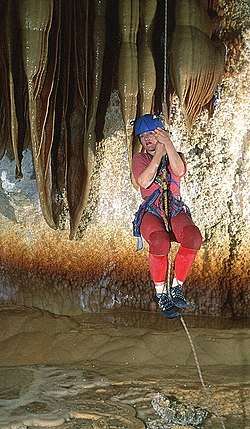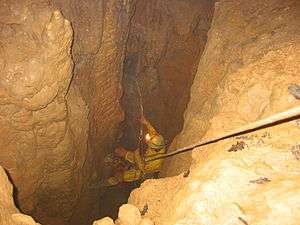Single-rope technique
Single-rope technique (SRT) is a set of methods used to descend and ascend on the same single rope. Single-rope technique is used in caving, potholing, rock climbing, canyoning, roped access for building maintenance and by arborists for tree climbing, although to avoid confusion in the tree climbing community, many have taken to calling it "stationary" rope technique.

Historical developments
In the 1930s, as caving became increasingly popular in France, several clubs in the Alps made vertical cave exploration an outdoor sport. During World War II, a team composed of Pierre Chevalier, Fernand Petzl, Charles Petit-Didier and others explored the Dent de Crolles cave system near Grenoble, France, which became the deepest explored cave in the world (-658m) at that time. The lack of available equipment during the war forced Pierre Chevalier and the rest of the team to develop their own equipment, leading to technical innovation. The first use of single-rope technique with prusik and mechanical rope ascenders (Henri Brenot's "monkeys", first used by Chevalier and Brenot in a cave in 1934) can be directly traced back to the exploration of the Dent de Crolles cave system. American caver Bill Cuddington, known as "Vertical Bill" developed single-rope techniques in the U.S. in the late 1950s. In 1958, two Swiss alpinists, Juesi and Marti teamed together, creating the first commercially available rope ascender known as the Jumar. In 1968 Bruno Dressler asked Petzl, who worked as a metals machinist, to build a rope-ascending tool, today known as the Petzl Croll, that he had developed by adapting the Jumar for pit caving. Petzl started a small caving equipment manufacturing company Petzl, which manufactures equipment for caving, climbing, mountaineering and at-height safety in civil engineering. The rappel rack was developed in the late 1960s by cavers in the Huntsville, Alabama caving club to facilitate long descents. The evolution of mechanical ascension systems helped extend the practice and safety of pit exploration.
Ascent
For ascent (prusiking or "jugging"), cammed devices (ascenders, Jumar, Petzl Croll) are used that can be pushed up the rope but lock and hold the user's weight when a downward force is applied; these must also be easily removable from the rope without being detached from the user. Knots such as the prusik, Bachmann and Klemheist are used to ascend ropes in emergencies in climbing and mountaineering; they have ceased to be the primary ascent method in single-rope technique because they are slow in use, and ice or mud greatly reduce their efficiency.
Numerous prusik systems have been devised. Popular systems are:
- Sit-stand systems (also known as frog rig) - one ascender is at chest level attached to the sit harness, and a second is held in the hand with a long loop of rope for the feet. Movement up the rope is by repeated moving of the foot loop ascender up the rope, pushing up with both feet together, and sitting, supported by the chest ascender. This motion appears like a frog kick.
- Rope-walking systems - one ascender attached directly to one foot, and the second connected to the other foot by a rope with the ascender higher up to avoid clashing. Movement up the rope is by alternate stepping movements with the feet.
Descent

Modern single-rope technique uses specialized devices for both descent and ascent, and low-stretch kernmantel rope of 8-11 mm diameter. Descent (abseiling or rappeling) uses various forms of friction brake to control speed. The most commonly used are the Petzl Stop (self-locking) and Bobbin, and rappel racks. For safe single-rope technique, especially on drops with complex rigging with intermediate belays, it is essential that the abseiling device can be removed from the rope without being unclipped from the harness. This is a problem with the simplest device, the single piece figure eight. These also twist the rope, which is a problem if there is a rebelay below so the rope cannot untwist itself. Figure eights and racks do have the advantage of being able to be used on a doubled rope. Other essential items of a personal single-rope technique set are a sit harness and one or more safety cords ("cow's tails") terminated in carabiners, for temporary attachment to safety ropes at the heads of drops and used in maneuvers at intermediate rope belays. To pass intermediate belays on a descent, the ascending devices may also be required.
Rigging
How the rope is sent down a shaft has great bearing on the type of single-rope technique used. In general, while rope-walking techniques may be very effective for climbing long unobstructed pitches, they prove less versatile in cases of awkward passages and complex rope rigging with re-belays used to avoid hazards such as loose rocks, waterfalls, and rope damage from rub points.
Rigging in the United States is typically done using a single anchor point, and pitches are rigged as a single long drop, often in excess of 100 meters. The rope is usually a thick abrasion-resistant type, which allows the rope to go over the lip of a shaft in contact with the rock. This is sometimes pejoratively called Indestructible Rope Technique. To descend such large drops on a bobbin-type descender would be difficult owing to the thickness and stiffness of the rope, and the resulting descent would be slow and jerky. The bobbin-descender could also overheat and melt the surface of the rope. Racks are preferred as they have a much larger heat sink capacity and offer a much smoother descent on such pitches. Using the frog system to ascend long pitches is time consuming, so rope-walking systems are preferred.
In Europe, pitches are often more complex, and multi-pitch rigging is used extensively. Long drops are broken into smaller pitches. Re-belays and deviations are used to direct the rope away from areas of sharp rock and from water. Where rope rub cannot be avoided, rope protectors are installed. Traverses are often installed to allow the rigger to reach an area where it is possible to hang the rope with no rub. Since allowing the rope to rub against the walls is prevented, lighter ropes are used, usually 8-9mm thick. This has the advantage of being lighter and therefore more economical to carry on long or deep trips. Bobbin descenders are quicker to change over at re-belays and are also lighter to carry. Deviations are short length of tape or rope pulling the main rope to one side with a carabiner which can be conveniently unclipped and replaced to allow passing. Rope-walking techniques are less effective in cases of awkward passageways and for changeovers at rebelays. Many caves have been equipped with bolt holes consisting of internally threaded metal inserts fixed into holes drilled in the rock. Subsequent visitors carry their own belay eyelets to bolt into these points. Selecting the best position for bolts needs particular care, the aim often being to achieve a 'Y' shaped rope hang between two bolts on opposite walls. This technique can help to prevent the rope from coming in contact with the rock, shares the load between the two belays, and reduces the shock load should one fail (in comparison with the use of a slack backup rope).
See also
References
- Sparrow, Andy (1996). The Complete Caving Manual. ISBN 978-1-86126-022-2.
- Smith, Bruce L. R.; Padgett, Allen; Speleological Society Vertical Section, National (1996). On rope: North American vertical rope techniques for caving... rappellers. Huntsville, Ala.: Vertical Section, National Speleological Society. ISBN 1-879961-05-9.CS1 maint: multiple names: authors list (link)
- Marbach, George; Tourte, Bernard; Alspaugh, Melanie. Alpine Caving Techniques. Speleo Projects, Switzerland. ISBN 3-908495-10-5.
- Lyon, Ben (1983). Venturing underground: the new speleo's guide. East Ardsley, Wakefield, West Yorkshire: EP Pub. ISBN 978-0-7158-0825-2.
- Elliot, Dave (1986). Single rope technique: a training manual. Oldham: Troll Safety Equipment. ISBN 978-0-904405-68-2.